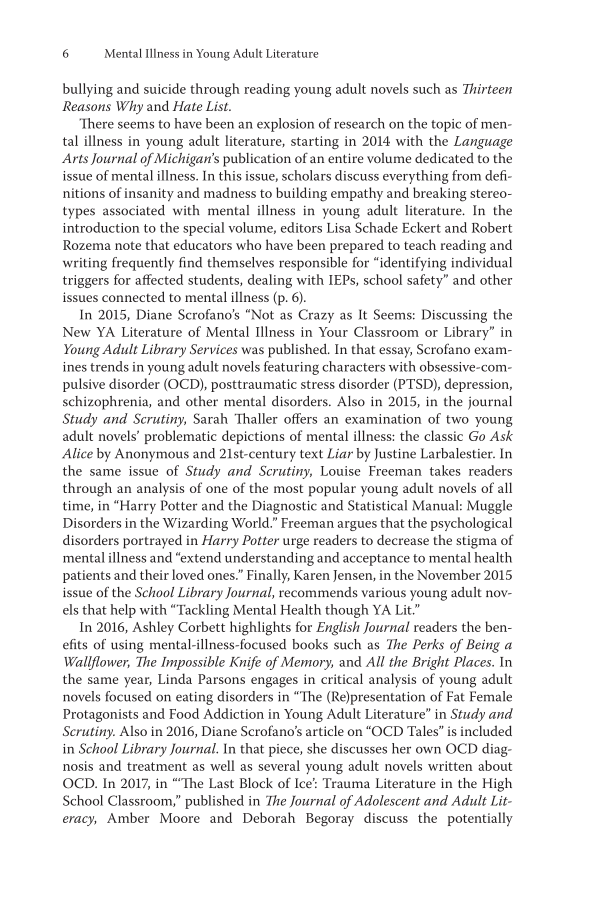6 Mental Illness in Young Adult Literature bullying and suicide through reading young adult novels such as Thirteen Reasons Why and Hate List. There seems to have been an explosion of research on the topic of men- tal illness in young adult literature, starting in 2014 with the Language Arts Journal of Michigan’s publication of an entire volume dedicated to the issue of mental illness. In this issue, scholars discuss everything from defi- nitions of insanity and madness to building empathy and breaking stereo- types associated with mental illness in young adult literature. In the introduction to the special volume, editors Lisa Schade Eckert and Robert Rozema note that educators who have been prepared to teach reading and writing frequently find themselves responsible for “identifying individual triggers for affected students, dealing with IEPs, school safety” and other issues connected to mental illness (p. 6). In 2015, Diane Scrofano’s “Not as Crazy as It Seems: Discussing the New YA Literature of Mental Illness in Your Classroom or Library” in Young Adult Library Services was published. In that essay, Scrofano exam- ines trends in young adult novels featuring characters with obsessive-com- pulsive disorder (OCD), posttraumatic stress disorder (PTSD), depression, schizophrenia, and other mental disorders. Also in 2015, in the journal Study and Scrutiny, Sarah Thaller offers an examination of two young adult novels’ problematic depictions of mental illness: the classic Go Ask Alice by Anonymous and 21st-century text Liar by Justine Larbalestier. In the same issue of Study and Scrutiny, Louise Freeman takes readers through an analysis of one of the most popular young adult novels of all time, in “Harry Potter and the Diagnostic and Statistical Manual: Muggle Disorders in the Wizarding World.” Freeman argues that the psychological disorders portrayed in Harry Potter urge readers to decrease the stigma of mental illness and “extend understanding and acceptance to mental health patients and their loved ones.” Finally, Karen Jensen, in the November 2015 issue of the School Library Journal, recommends various young adult nov- els that help with “Tackling Mental Health though YA Lit.” In 2016, Ashley Corbett highlights for English Journal readers the ben- efits of using mental-illness-focused books such as The Perks of Being a Wallflower, The Impossible Knife of Memory, and All the Bright Places. In the same year, Linda Parsons engages in critical analysis of young adult novels focused on eating disorders in “The (Re)presentation of Fat Female Protagonists and Food Addiction in Young Adult Literature” in Study and Scrutiny. Also in 2016, Diane Scrofano’s article on “OCD Tales” is included in School Library Journal. In that piece, she discusses her own OCD diag- nosis and treatment as well as several young adult novels written about OCD. In 2017, in “‘The Last Block of Ice’: Trauma Literature in the High School Classroom,” published in The Journal of Adolescent and Adult Lit- eracy, Amber Moore and Deborah Begoray discuss the potentially
Document Details My Account Print multiple pages
Print
You have printed 0 times in the last 24 hours.
Your print count will reset on at .
You may print 0 more time(s) before then.
You may print a maximum of 0 pages at a time.


































































































































































































































